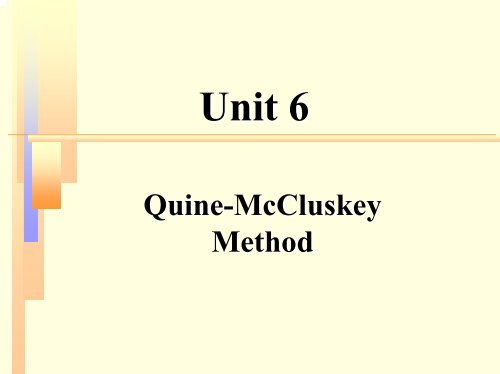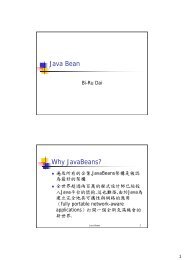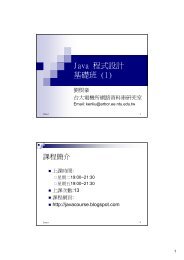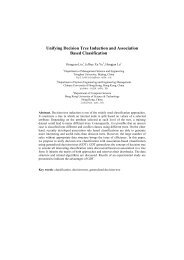Prime Implicant
Prime Implicant
Prime Implicant
Create successful ePaper yourself
Turn your PDF publications into a flip-book with our unique Google optimized e-Paper software.
Unit 6<br />
Quine-McCluskey<br />
Quine McCluskey<br />
Method
Quine-McCluskey<br />
Quine McCluskey Method<br />
Quine-McCluskey<br />
McCluskey Mathod<br />
Quine<br />
6.1 Determination of <strong>Prime</strong> <strong>Implicant</strong>s<br />
6.2 The <strong>Prime</strong> <strong>Implicant</strong> Chart<br />
6.3 Petrick’s Petrick Method<br />
6.4 Simplification of Incompletely Specified<br />
Functions<br />
6.5 Simplification Using Map-Entered<br />
Map Entered<br />
Variables<br />
6.6 Conclusions<br />
Unit 06 2
Quine-McCluskey<br />
Quine McCluskey Method<br />
Cover: A switching function f(x (x1,x ,x2,…,xn) ) is said to<br />
cover another function g(x (x1,x ,x2,…,xn), ), if f assumes the<br />
value 1 whenever g does.<br />
<strong>Implicant</strong> : Given a function F of n variables, a<br />
product term P is an implicant of F iff for every<br />
combination of values of the n variables for which<br />
P=1 , F is also equal 1.That is, P=1 implies F=1. F=1<br />
Cover:<br />
<strong>Implicant</strong><br />
<strong>Prime</strong> <strong>Implicant</strong>: <strong>Implicant</strong> A<br />
<strong>Prime</strong><br />
A prime implicant of a<br />
function F is a product term implicart which is no<br />
longer an implicant if any literal is deleted from it.<br />
Essential <strong>Prime</strong> <strong>Implicant</strong>: <strong>Implicant</strong> If<br />
If a minterm is<br />
covered by only one prime implicant, implicant,<br />
then that prime<br />
implicant is called an essential prime implicant.<br />
implicant<br />
Unit 06 3
Quine-McCluskey<br />
Quine McCluskey Method<br />
On a Karnaugh Map<br />
Any single 1 or any group of 1’s 1 s (2 k 1’s, s, k=0,1,2,…) k=0,1,2, )<br />
which can be combined together on a map of the<br />
function F represents a product term which is<br />
called an implicant of F.<br />
A product term implicant is called a prime implicant<br />
if it cannot be combined with another term to<br />
eliminate a variable.<br />
If a minterm is covered by only one prime implicant, implicant,<br />
then that prime implicant is called an essential<br />
prime implicant.<br />
implicant<br />
Unit 06 4
Quine-McCluskey<br />
Quine McCluskey Method<br />
A systematic simplification procedure<br />
Input: Input:<br />
minterm expansion<br />
Output: Output:<br />
a minimum sum of products<br />
Method: Method<br />
1. Generate all prime implicants<br />
Eliminate as many literals as possible from each<br />
term by systematically applying the theorem<br />
XY+XY’=X XY+XY =X<br />
2. Find the minimum solution<br />
Use a prime implicant chart to select a minimum<br />
set of prime implicants which contain a minimum<br />
number of literals.<br />
1.<br />
2.<br />
Unit 06 5
Quine-McCluskey<br />
Quine McCluskey Method<br />
Example: : F(a,b,c)= F(a,b,c)=a’b’c’+ab<br />
+ab’c’+ab +ab’c+abc c+abc<br />
All <strong>Implicant</strong>s: <strong>Implicant</strong>s:<br />
a’b’c’,ab ,ab’c’,ab ,ab’c,abc c,abc<br />
ab’,b ab ,b’c’,ac ,ac<br />
<strong>Prime</strong> <strong>Implicant</strong>s: <strong>Implicant</strong>s<br />
ab’,b ab ,b’c’,ac ,ac<br />
Essential <strong>Prime</strong> <strong>Implicant</strong>s: <strong>Implicant</strong>s<br />
b’c’,ac ,ac<br />
Minimum sum of products: products<br />
F(a,b,c)= F(a,b,c)=b’c’+ac<br />
+ac<br />
Example<br />
Unit 06 6
Quine-McCluskey<br />
Quine McCluskey Method<br />
Quine-McCluskey<br />
Quine McCluskey Method: Method<br />
1. Find all of the prime implicants of the<br />
function.<br />
2. Construct the prime implicant table and find<br />
the essential prime implicants of the function.<br />
3. Include the essential prime implicants in the<br />
minimal sum.<br />
Unit 06 7
Quine-McCluskey<br />
Quine McCluskey Method<br />
Quine-McCluskey<br />
Quine McCluskey Method: Method<br />
4. Manipulate the prime implicant table.<br />
4-1. . Delete all essential prime implicant from the<br />
prime implicant table,<br />
4-2. 2. Determine and delete the dominated rows<br />
and dominating columns in the table,<br />
4-3. 3. Find the (secondary ( secondary) ) essential implicants. implicants<br />
5. Repeat Steps 3 and 4 as many times as they<br />
are applicable until a minimal cover of the<br />
function is found.<br />
Unit 06 8
Determination of <strong>Prime</strong> <strong>Implicant</strong>s<br />
Find all of the prime implicants<br />
Find<br />
(1). Represent each minterm by a binary code. code<br />
(2). Find the decimal number for each binary code.<br />
(3). Define the number of 1’s 1 s in binary number as<br />
the index of the number.<br />
(3 (3-1). 1). Group all the binary numbers of the same<br />
index into a group.<br />
(3 (3-2). 2). List all the groups in a column in the index<br />
ascending order. order<br />
(3 (3-3). 3). Within each group, the binary number are<br />
listed in the ascending order of their decimal-number<br />
decimal number<br />
equivalent.<br />
equivalent<br />
Unit 06 9
Determination of <strong>Prime</strong> <strong>Implicant</strong>s<br />
(4). Start with the terms in the set of lowest<br />
index; index;<br />
compare them with those, if any, in<br />
the set whose index is 1 greater, greater,<br />
and<br />
eliminate all redundant variables by<br />
XY+XY’=X. XY+XY =X.<br />
(5). Check off all the terms that entered into<br />
the combinations.<br />
combinations.<br />
The ones that are left are<br />
prime implicants. implicants<br />
(6). Repeat Steps (4) and (5) until no further<br />
reduction is possible.<br />
Unit 06 10
Determination of <strong>Prime</strong> <strong>Implicant</strong>s<br />
Example: Find<br />
Example: Find all of the prime implicants<br />
f<br />
( a,<br />
b,<br />
c,<br />
d)<br />
= ∑ m(<br />
0,<br />
1,<br />
2,<br />
5,<br />
6,<br />
7,<br />
8,<br />
9,<br />
10,<br />
14)<br />
implicants of the function<br />
Unit 06 11
Determination of <strong>Prime</strong> <strong>Implicant</strong>s<br />
Example: Find<br />
Example: Find all of the prime implicants<br />
f<br />
( a,<br />
b,<br />
c,<br />
d)<br />
= ∑ m(<br />
0,<br />
1,<br />
2,<br />
5,<br />
6,<br />
7,<br />
8,<br />
9,<br />
10,<br />
14)<br />
implicants of the function<br />
Unit 06 12
Determination of <strong>Prime</strong> <strong>Implicant</strong>s<br />
Example (Cont.):<br />
Minimum form ???<br />
Unit 06 13
The <strong>Prime</strong> <strong>Implicant</strong> Chart<br />
Construct the <strong>Prime</strong> <strong>Implicant</strong> Table<br />
(Chart) and find the Essential <strong>Prime</strong><br />
<strong>Implicant</strong>s of the function<br />
Construct<br />
(1) Construct the prime implicant table<br />
(1)<br />
(1 (1-1) 1) Each column carries a decimal number<br />
at the top which correspond to the one of<br />
the minterm in the given function,<br />
(1 (1-2) 2) The column are assigned by such a<br />
number in ascending order, order<br />
(1 (1-3) 3) Each row corresponds to one of the<br />
prime implicants, implicants,<br />
P1,P2,….<br />
P1,P2,<br />
Unit 06 14
The <strong>Prime</strong> <strong>Implicant</strong> Chart<br />
(2) Make a cross under each decimal<br />
number that is a term contained in the<br />
prime implicant represented by that row.<br />
(3) Find all the columns that contain a<br />
single cross and circle them; place an<br />
asterisk * at the left of those rows in which<br />
you circle a cross.<br />
The rows marked with an asterisk are the<br />
essential prime implicants.<br />
implicants<br />
Unit 06 15
The <strong>Prime</strong> <strong>Implicant</strong> Chart<br />
Example:<br />
Unit 06 16
The <strong>Prime</strong> <strong>Implicant</strong> Chart<br />
Example:<br />
Unit 06 17
The <strong>Prime</strong> <strong>Implicant</strong> Chart<br />
Example with a cyclic prime implicant<br />
table<br />
F<br />
= ∑ m(<br />
0,<br />
1,<br />
2,<br />
5,<br />
6,<br />
7)<br />
Sol: Sol:<br />
Find all of the prime implicants<br />
Unit 06 18
The <strong>Prime</strong> <strong>Implicant</strong> Chart<br />
Sol(cont.): Sol(cont.):<br />
Select P1 first.<br />
The minimum sum of products<br />
F =<br />
a′<br />
b′<br />
+ bc′<br />
+<br />
ac<br />
Unit 06 19
The <strong>Prime</strong> <strong>Implicant</strong> Chart<br />
Sol(cont.): Sol(cont.):<br />
Select P2 first.<br />
The minimum sum of products<br />
The minimum sum of product is not unique. unique<br />
F =<br />
a′<br />
c′<br />
+ b′<br />
c +<br />
ab<br />
Unit 06 20
Petrick’s Petrick Method<br />
A technique for determining all minimum<br />
sum-of sum of-products products solutions from a prime<br />
implicant table.<br />
Before applying Petrick’s Petrick method, all<br />
essential prime implicants and minterms<br />
they cover should be removed from the<br />
table.<br />
Unit 06 21
Petrick’s Petrick Method<br />
Petrick’s Method<br />
Petrick<br />
1. Label the rows of the table, P 1,P ,P2 ,…<br />
2. Form a logic function P(P 1,P ,P2 ,…), ), which<br />
is true when all of the minterms in the table<br />
have been covered.<br />
3. Reduce P to a minimum sum of products<br />
using (X+Y)(X+Z)=X+YZ and X+XY=X.<br />
4. Select one solution that has minimum<br />
number of prime implicant, implicant,<br />
minimum<br />
number of literals.<br />
Unit 06 22
Petrick’s Petrick Method<br />
Example: Example:<br />
F<br />
= ∑ m(<br />
0,<br />
1,<br />
2,<br />
5,<br />
6,<br />
7)<br />
Unit 06 23
Petrick’s Petrick Method<br />
Example (cont.):<br />
In order to cover minterm 0, we must choose<br />
P1 or P 2 ; therefore, the expression P 1+P +P2 must be true.<br />
cover 0 P1+P +P2 1 P1+P +P3 2 P2+P +P4 5 P3+P +P5 6 P4+P +P6 7 P5+P +P 6<br />
Unit 06 24
Petrick’s Petrick Method<br />
Example (cont.):<br />
P = P + P )( P + P)(<br />
P + P )( P + P )( P + P )( P + P ) = 1<br />
( 1 2 1 3 2 4 3 5 4 6 5 6<br />
Using (<br />
X + Y )( X + Z)<br />
= X + YZ and the<br />
distributive law<br />
Unit 06 25
Petrick’s Petrick Method<br />
Example (cont.):<br />
Use to delete redundant terms from P<br />
P = PP<br />
P + PP<br />
P P + P PP<br />
P + P PP<br />
P<br />
1<br />
1<br />
1<br />
4<br />
4<br />
3<br />
5<br />
+ PP<br />
P P<br />
= PP<br />
P<br />
5<br />
4<br />
6<br />
1<br />
1<br />
2<br />
2<br />
3implicants<br />
Two minimum solutions:<br />
F<br />
F<br />
=<br />
=<br />
X + XY =<br />
P<br />
1<br />
P<br />
2<br />
1<br />
5<br />
5<br />
2<br />
4<br />
6<br />
+ P P PP<br />
+ PP<br />
P P<br />
+<br />
+<br />
P<br />
4<br />
P<br />
3<br />
+<br />
+<br />
6<br />
P<br />
P<br />
3<br />
X<br />
6<br />
2<br />
2<br />
3<br />
3<br />
2<br />
4<br />
4<br />
4<br />
3<br />
5<br />
+ P PP<br />
+ P PP<br />
P<br />
5<br />
6<br />
5<br />
4<br />
P<br />
6<br />
2<br />
1<br />
3<br />
3<br />
5<br />
2<br />
4<br />
4<br />
3<br />
6<br />
+ P PP<br />
+ PP<br />
P P<br />
= a′<br />
b′<br />
+ bc′<br />
+ ac<br />
= a′<br />
c′<br />
+ b′<br />
c +<br />
6<br />
ab<br />
6<br />
+ P PP<br />
2<br />
3<br />
6<br />
3<br />
Unit 06 26
Simplification of Incompletely<br />
Specified Functions<br />
Modify the Quine-McCluskey<br />
Quine McCluskey procedure<br />
Finding the <strong>Prime</strong> <strong>Implicant</strong>s<br />
Treat Treat the don’t don t care terms as if they were<br />
required minterms. minterms<br />
Forming the <strong>Prime</strong> <strong>Implicant</strong> Table<br />
The The don’t don t cares are not list at the top of the<br />
table.<br />
Unit 06 27
Simplification of Incompletely<br />
Specified Functions<br />
Example: Simplify<br />
F<br />
A,<br />
B,<br />
C,<br />
D)<br />
∑ m(<br />
2,<br />
3,<br />
7,<br />
9,<br />
11,<br />
13)<br />
+<br />
Sol: Treat the don’t don t cares (1,10,15) as<br />
required minterms<br />
( d<br />
= ∑ ( 1,<br />
10,<br />
15)<br />
Unit 06 28
Simplification of Incompletely<br />
Specified Functions<br />
Sol(cont.): .): The don’t don t cares are not list<br />
at the top of the table<br />
Sol(cont<br />
Unit 06 29
Simplification Using Map-Entered<br />
Map Entered<br />
Variables<br />
Map-Entered Map Entered Variables –<br />
A modification of the Karnaugh Map<br />
Quine-McCluskey<br />
Quine McCluskey Method<br />
Can be used with functions with a fairly<br />
large number of variables. variables<br />
Not very efficient for functions that have<br />
many variables and relatively few terms<br />
Unit 06 30
Simplification Using Map-Entered<br />
Map Entered<br />
Variables<br />
Map-Entered Entered Variables<br />
Map<br />
Example:<br />
F ( A,<br />
B,<br />
C,<br />
D)<br />
= A′<br />
B′<br />
C + A′<br />
BC + A′<br />
BC′<br />
D + ABCD+<br />
( AB′<br />
C)<br />
where (AB’C) (AB C) is don’t don t care. D appears in only two terms,<br />
choose D as a map-entered map entered variable. variable.<br />
F(<br />
A,<br />
B,<br />
C,<br />
D)<br />
=<br />
A′<br />
B′<br />
C+<br />
A′<br />
BC+<br />
A′<br />
BC′<br />
D+<br />
ABCD+<br />
( AB′<br />
C)<br />
= A′<br />
B′<br />
C+<br />
A′<br />
BC+<br />
( A′<br />
BC′<br />
) D+<br />
( ABC)<br />
D+<br />
( AB′<br />
C)<br />
=<br />
m<br />
1<br />
+<br />
m<br />
3<br />
+<br />
m<br />
2<br />
D<br />
+<br />
( m<br />
Unit 06 31<br />
m<br />
7<br />
D<br />
+<br />
5<br />
)
Simplification Using Map-Entered<br />
Map Entered<br />
Variables<br />
Example (cont.):<br />
Unit 06 32
Simplification Using Map-Entered<br />
Map Entered<br />
Variables<br />
Map-Entered Map Entered Variables<br />
Example:<br />
G(<br />
A,<br />
B,<br />
C,<br />
D,<br />
E,<br />
F)<br />
=<br />
m<br />
0<br />
+ m<br />
+ ( m ) + ( m<br />
1<br />
2<br />
+ m<br />
3<br />
10<br />
+ Em<br />
) + ( m<br />
5<br />
13<br />
+ Em<br />
)<br />
Unit 06 33<br />
7<br />
+ Fm<br />
9<br />
+ m<br />
11<br />
+ m<br />
15
Simplification Using Map-Entered<br />
Map Entered<br />
Variables<br />
General Method of Simplifying Functions<br />
Using Map-entered Map entered Variables<br />
If a variable Pi is placed in square mj of a map of<br />
function F, , this means that F=1 =1 when Pi=1 =1 and the<br />
variable are chosen so that mj=1. =1.<br />
F =<br />
MS<br />
MS<br />
i<br />
:<br />
0<br />
+ PMS<br />
1<br />
Minimum<br />
Sum<br />
+ ...<br />
Unit 06 34<br />
1<br />
+<br />
P<br />
2<br />
MS<br />
2
Simplification Using Map-Entered<br />
Map Entered<br />
Variables<br />
MS<br />
<br />
0 is the minimum sum obtained by<br />
setting P1<br />
= P2<br />
= ... = . 0<br />
MS is the minimum sum obtained by setting<br />
1<br />
setting<br />
P1 = 1,<br />
Pj<br />
= 0(<br />
j ≠ 1)<br />
and replacing all 1’s 1 s on the map<br />
with don’t don t cares. cares<br />
MS is the minimum sum obtained by setting<br />
i<br />
Pi =<br />
1, Pj<br />
= 0(<br />
j ≠ i)<br />
and replacing all 1’s 1 s on the map<br />
with don’t don t cares. cares<br />
The resulting expression for F is<br />
F<br />
= MS + PMS<br />
+ P MS<br />
0<br />
1<br />
1<br />
+ ...<br />
The expression will not generally be minimum if the<br />
variables P 1,P ,P2,… are dependent (e.g. P 1=E, =E, P 2=E =E’,…). ).<br />
2<br />
2<br />
Unit 06 35
Simplification Using Map-Entered<br />
Map Entered<br />
Variables<br />
Map-Entered Entered Variables<br />
Map<br />
Example: Use Map-entered Map entered Variables to simplify<br />
the function<br />
F ( A,<br />
B,<br />
C,<br />
D)<br />
= A′<br />
B′<br />
C + A′<br />
BC + A′<br />
BC′<br />
D + ABCD+<br />
( AB′<br />
C)<br />
where (AB’C) (AB C) is don’t don t care.<br />
Sol: D appears in only two terms, choose D as a map-entered<br />
map entered<br />
variable. variable.<br />
Sol:<br />
F(<br />
A,<br />
B,<br />
C,<br />
D)<br />
=<br />
A′<br />
B′<br />
C+<br />
A′<br />
BC+<br />
A′<br />
BC′<br />
D+<br />
ABCD+<br />
( AB′<br />
C)<br />
= A′<br />
B′<br />
C+<br />
A′<br />
BC+<br />
( A′<br />
BC′<br />
) D+<br />
( ABC)<br />
D+<br />
( AB′<br />
C)<br />
=<br />
m<br />
1<br />
+<br />
m<br />
3<br />
+<br />
m<br />
2<br />
D<br />
+<br />
( m<br />
Unit 06 36<br />
m<br />
7<br />
D<br />
+<br />
5<br />
)
Simplification Using Map-Entered<br />
Map Entered<br />
Variables<br />
Sol (cont.):<br />
Unit 06 37
Simplification Using Map-Entered<br />
Map Entered<br />
Variables<br />
Sol(cont.): Sol(cont<br />
.): F ( A,<br />
B,<br />
C,<br />
D)<br />
= A′<br />
B′<br />
C + A′<br />
BC + A′<br />
BC′<br />
D + ABCD + ( AB′<br />
C)<br />
F = A′<br />
C + D(<br />
C + A′<br />
B)<br />
= A′<br />
C + CD + A′<br />
BD<br />
Unit 06 38
Simplification Using Map-Entered<br />
Map Entered<br />
Variables<br />
Example: : Use the Map-Entered Map Entered Variables method<br />
to simplify the function<br />
Example<br />
G(<br />
A,<br />
B,<br />
C,<br />
D,<br />
E,<br />
F)<br />
= m<br />
Let P1=E, =E, P 2=F =F. .<br />
0<br />
+ m<br />
+ ( m ) + ( m<br />
1<br />
2<br />
+ m<br />
3<br />
10<br />
+ Em<br />
) + ( m<br />
5<br />
13<br />
+ Em<br />
)<br />
7<br />
+ Fm<br />
9<br />
+ m<br />
Unit 06 39<br />
11<br />
+ m<br />
15
Simplification Using Map-Entered<br />
Map Entered<br />
Variables<br />
Example (cont.): (cont.)<br />
MS 0 : The minimum inimum sum um obtained by setting P 1=P =P2=0 =0 (E=F=0).<br />
MS 1 : The minimum inimum sum um obtained by setting P 1=1, =1, P 2=0 =0 (E=1. F=0).<br />
MS2<br />
: The minimum inimum sum um obtained by setting P 1=0, =0, P 2=1 =1 (E=0, F=1).<br />
MS 2<br />
G<br />
=<br />
MS<br />
0<br />
+ PMS<br />
1<br />
1<br />
+ P MS<br />
= A′<br />
B′<br />
+ ACD + EA′<br />
D + FAD<br />
2<br />
2<br />
= ( A′<br />
B′<br />
+ ACD)<br />
+ E(<br />
A′<br />
D)<br />
+ F(<br />
AD)<br />
Unit 06 40














